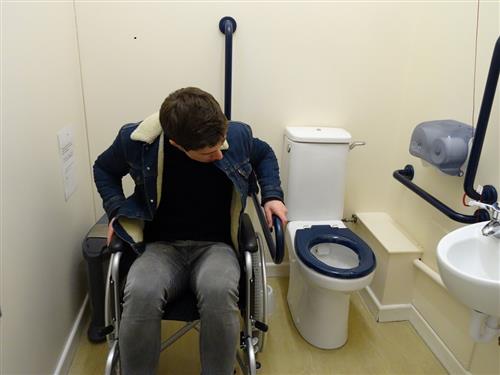
Visiting speaker David Flatla and Typography undergraduate Ryzard Akita engaged in an exciting discussion of cross-disciplinary challenges for inclusive design
Last week, BdB looked deeper into issues around colour and accessibility with visiting speaker Dr David Flatla.
David is a Lecturer and founding director of the Digitally-Augmented Perception Research Lab (DAPRlab) at the University of Dundee. DAPRlab seeks to digitally enhance the perceptual abilities of people with both atypical and typical sensory abilities. David’s particular research interests lie in developing personalised models and new assistive technology to help people with impaired colour vision. His previous work has received Best Paper awards from CHI and ASSETS, and he received a Canadian Governor General’s Gold Medal for his PhD research.
David described his involvement with recent bottom-up (assistive tech) and top-down (designers) approaches to addressing challenges for users with different kinds of impaired colour vision (ICV – more commonly known as colourblindness). Colour vision is a vital component of everyday living and its loss can severely limit a person’s livelihood, threaten health and safety, make food preparation difficult, and even challenge someone’s social acceptability. In spite of these complications, visual designs that employ inaccessible colour choices abound, and people who experience impaired colour vision have little assistive technology to help overcome these challenges.
David’s talk was well-received by the undergraduate and postgraduate students from different programmes who attended the talk. Leo Poppa, a final year MEng Cybernetics student said “David’s presentation provided me with invaluable perspective of how people with ICV perceive and interact with objects in the world. What surprised me the most was that both people with impaired sensory capabilities as well as those with ‘typical’ abilities could be assisted by his research, something I had not taken into account. Whilst colour accessibility is easy for engineers to overlook when designing and implementing a product, I feel that this seminar provides a concise set of techniques that can be used to improve accessibility of future engineering projects. Hence, this talk is a must-see for any engineer wishing to improve their design practices.”
Typography undergraduate Ryzard Akita is designing a prototype for a food app for users with visual-impairments as part of his final year self-directed project. Ryzard said: “David’s talk on colour accessibility was very insightful. He highlighted the importance of understanding inclusive design and discussed how individuals live with ICV on a daily basis. Unfortunately, colour accessibility is something that is often overlooked in the design industry. So to counter this David encourages designers not be one minded and has suggested tools available to aid the inclusive design process.
“This was an eye opener for me as there was so much to take into consideration. I was even fortunate enough to speak to David himself after his talk. He gave me further advice on my University project and even explained in detail how these tools can be applied to my design process. I truly believe that I benefited from this talk and I recommend it to any designer who is unaware about the importance of considering colour accessibility.”
David’s visit was hosted by BdB team member Faustina Hwang and the School of Systems Engineering. Our BdB team look forward to hosting more seminars with cross-disciplinary relevance.









